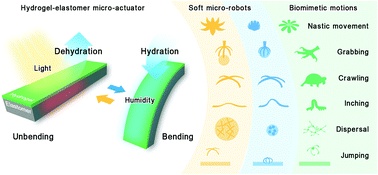Co-doping optimized hydrogel-elastomer micro-actuators for versatile biomimetic motions†
Abstract
Hydrogels can respond to changes in humidity or temperature, while elastomers can resist structural collapse due to dehydration or external force application. A hybrid bilayer of hydrogel-elastomers while retaining the merits of both the hydrogels and elastomers has emerged as a promising stimuli-responsive micro-actuator. However, the preparation of a hydrogel-elastomer micro-actuator requires multiple steps, mainly due to the differences in the surface properties of these two materials. Among them, the steps to surface-treat the elastomer and functionalize the material of each layer involve intricate processes and excessive consumption of resources. In this work, we introduce a co-doping method to optimize the preparation of a stimuli-responsive hydrogel-elastomer micro-actuator. The surface treatment and functionalization processes are combined into one step by directly doping the polymerization initiator and functional nanomaterials into the hybrid bilayer. The thermo-responsive hydrogel is combined with a photothermal elastomer to fabricate a soft micro-actuator that can bend and unbend in response to changes in humidity and light. Based on this actuator, a set of biomimetic soft micro-robots were developed, demonstrating a series of motions, such as grabbing, crawling, and jumping. This strategy of stimuli-responsive micro-actuator preparation can benefit the hydrogel-elastomer hybrid micro-robot designs for applications ranging from self-locomotive robots in environmental monitoring to drug delivery in biomedical engineering.

- This article is part of the themed collection: Advanced Functional Nanomaterials for Biomedical Applications


 Please wait while we load your content...
Please wait while we load your content...